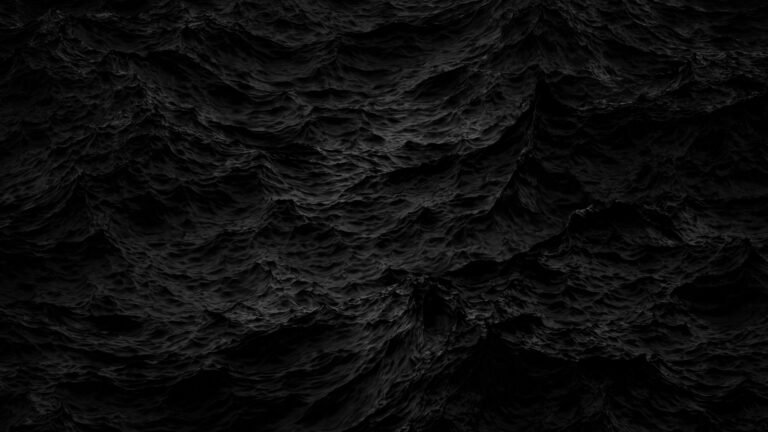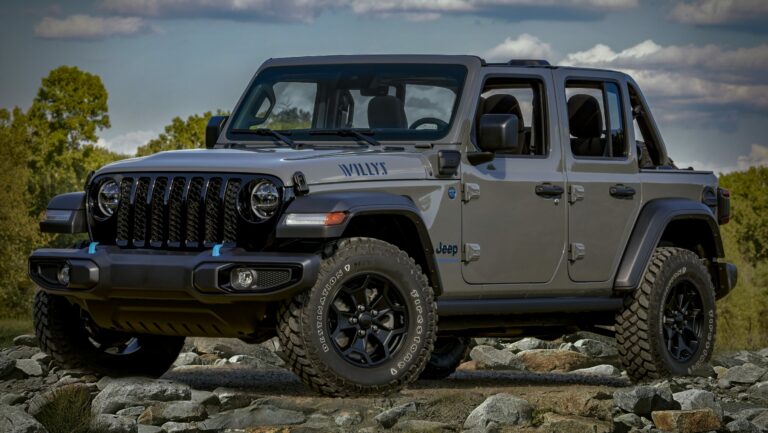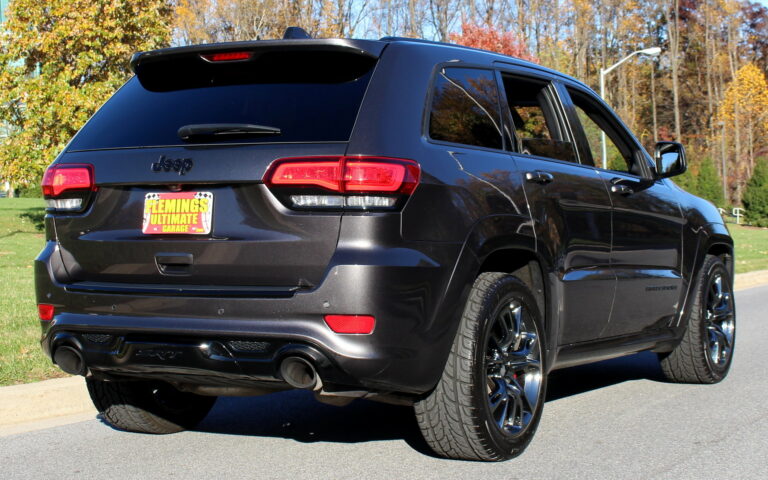Jeep CJ7 Body For Sale: Your Comprehensive Guide to Restoring an Icon
Jeep CJ7 Body For Sale: Your Comprehensive Guide to Restoring an Icon jeeps.truckstrend.com
The Jeep CJ7, an icon of American automotive history, evokes images of open-air freedom, rugged off-road capability, and a timeless design that continues to captivate enthusiasts worldwide. Produced from 1976 to 1986, the CJ7 struck a perfect balance between the traditional utilitarianism of its predecessors and a touch more comfort and refinement, making it incredibly popular. Today, decades after its final production, the allure of the CJ7 remains as strong as ever, driving a vibrant market for restoration projects, custom builds, and parts. Among the most crucial components for any significant CJ7 revival is the body itself.
Searching for a "Jeep CJ7 body for sale" isn’t just about finding a piece of metal or fiberglass; it’s about laying the foundation for a dream vehicle. Whether you’re aiming for a meticulous factory-spec restoration, a modern "restomod" with classic looks and contemporary performance, or simply repairing significant rust or collision damage, the quality and type of body you acquire will dictate the success and enjoyment of your project. This comprehensive guide will navigate you through the intricate world of CJ7 body acquisition, offering insights, practical advice, and essential considerations to help you find the perfect shell for your legendary build.
Jeep CJ7 Body For Sale: Your Comprehensive Guide to Restoring an Icon
The Enduring Appeal of the Jeep CJ7
The Jeep CJ7 represents a sweet spot in the Civilian Jeep lineage. It retained the iconic flat fenders and removable doors but introduced a slightly longer wheelbase than the CJ5, enhancing stability and ride comfort without sacrificing its legendary off-road prowess. Its simple, robust construction, combined with a wide array of engine options (from the reliable AMC 258 I6 to the potent AMC 304 V8), made it a versatile and beloved vehicle. This blend of heritage and practicality ensures its continued popularity, leading to a consistent demand for quality parts, especially bodies, to bring these classic Jeeps back to life.
Why Buy a CJ7 Body? Common Scenarios
The decision to purchase a standalone CJ7 body typically stems from several key scenarios, each with its unique motivations:
- Full Restoration Projects: The most common reason. Original CJ7 bodies, especially in regions prone to rust (like the salt belt), often suffer from severe corrosion in floorboards, frame mounts, rocker panels, and cowls. A new or better-condition body is essential for a true restoration.
- Custom Builds & Restomods: For enthusiasts looking to create a unique vehicle, starting with a bare body allows for maximum customization. This could involve fitting modern powertrains, suspension systems, or interior components while retaining the classic CJ7 silhouette.
- Repairing Damaged Frames/Bodies: If an existing CJ7 has been involved in an accident or suffered extensive frame damage, but the title and other components are salvageable, replacing the body is often more cost-effective and structurally sound than extensive repairs.
- Salvaging a In some cases, a CJ7 might have a good, clear title but a completely unsalvageable body and frame. Acquiring a new body and transferring the VIN (where legal and applicable) can bring the vehicle back to life without the complexities of titling a new "kit car."

Types of CJ7 Bodies Available
When searching for a CJ7 body, you’ll primarily encounter three main types, each with distinct characteristics, pros, and cons:
-
Original/Used Steel Bodies (OEM):
- Description: These are bodies pulled from existing CJ7s. Their condition varies wildly, from surprisingly solid "barn finds" to utterly rusted-out shells.
- Pros: Originality, factory stampings, potentially cheaper upfront if in poor condition.
- Cons: Almost always require significant rust repair, bodywork, and painting. Finding a truly rust-free original body is rare and expensive. May have hidden damage from previous accidents or poor repairs.
- Best For: Purists seeking absolute originality, or those with advanced bodywork skills and a tight budget.
-
Aftermarket Steel Reproduction Bodies:
- Description: Brand new bodies manufactured from steel, designed to replicate the original CJ7 specifications. These are often produced by specialized companies.
- Pros: No rust, fresh steel, precise fitment (usually), many come pre-drilled for components. Offers the authentic feel and weight of an original steel body.
- Cons: More expensive than used bodies. Still require painting and final prep. Can be heavy for shipping.
- Best For: Restorers wanting a durable, long-lasting steel body without the hassle of extensive rust repair, offering a factory-new starting point.
-
Aftermarket Fiberglass Reproduction Bodies:
- Description: New bodies molded from fiberglass, designed to mimic the CJ7’s dimensions.
- Pros: Completely rust-proof, lightweight (improving fuel economy and performance), often smoother surfaces requiring less prep for paint, easier to repair minor damage.
- Cons: Different feel and sound than steel (some enthusiasts dislike the "tinny" sound), can be more prone to cracking under extreme stress (though modern fiberglass is very durable), painting requires specific techniques.
- Best For: Off-roaders seeking weight reduction, those in rust-prone climates, or builders prioritizing low maintenance and ease of repair.
Key Considerations When Buying a CJ7 Body
Acquiring a CJ7 body is a significant investment in time and money. Careful consideration of these factors will save you headaches down the road:
- Condition is Paramount:
- Rust: The biggest enemy of any CJ7. Inspect floorboards (especially under the pedals and seats), rocker panels, body mounts, cowl area (where the windshield frame attaches), fender wells, and the rear tailgate area. Pay attention to patches – are they done properly or just hiding bigger problems?
- Dents & Damage: Assess the extent of body damage. Minor dents are fixable, but major collision damage can compromise structural integrity and require extensive, costly repairs.
- Alignment: Check door gaps, hood fitment, and tailgate alignment. Misalignment can indicate previous frame damage or poor repairs.
- Previous Repairs: Look for signs of bondo or poor welds. A magnet can help detect thick layers of body filler.
- Completeness:
- Are you buying a bare tub (just the main body structure), or does it include fenders, grille, windshield frame, tailgate, and hood? More complete kits are often more expensive but save time sourcing individual parts.
- Material (Steel vs. Fiberglass): Revisit the pros and cons discussed above. Your intended use (daily driver, hardcore off-roader, show truck) will influence this choice.
- Donor Vehicle Compatibility: While most CJ7 bodies are interchangeable across the model years, minor differences exist. For example, early CJ7s (1976-1980) had a narrow-track axle, while later models (1981-1986) had wide-track axles, affecting fender flares and potentially body mount locations if the frame is swapped. Always verify compatibility with your frame and components.
- Legalities & Documentation:
- Bill of Sale: Always get a clear Bill of Sale detailing the transaction.
- VIN Plate: If the body comes with a VIN plate, understand the legal implications of transferring it. In most states, the VIN belongs to the frame, not the body. Consult your local DMV regarding body swaps and titling. Never buy a body with a suspicious or missing VIN.
- Logistics & Transportation:
- Shipping Costs: A CJ7 body is large and heavy. Shipping can be expensive, often costing hundreds to over a thousand dollars depending on distance. Get quotes before committing to a purchase.
- Pickup: If picking up, ensure you have appropriate transportation (large trailer or flatbed truck) and help for loading/unloading.
- Storage: Where will you store the body during your project? It needs to be a dry, secure location.
Where to Find a CJ7 Body For Sale
The market for CJ7 bodies is active, but finding the right one requires diligence:
- Online Marketplaces:
- eBay: Good for new aftermarket bodies (steel and fiberglass) and occasionally used ones.
- Craigslist/Facebook Marketplace: Excellent for local finds, especially used bodies. Be wary of scams and always inspect in person.
- Specialized Forums & Classifieds: Websites like Pirate4x4.com, JeepForum.com, and specific CJ7 owner groups on Facebook often have dedicated classified sections where enthusiasts sell parts.
- Specialized Jeep Parts Dealers & Restoration Shops: Companies like Quadratec, Morris 4×4, and Omix-Ada often carry new aftermarket steel or fiberglass bodies. Restoration shops may also have used bodies for sale or know where to source them.
- Salvage Yards/Junkyards: Can be a goldmine for original used bodies, but expect significant rust and damage. You’ll need to do the legwork to find them.
- Word of Mouth: Let fellow Jeep enthusiasts know you’re looking. The Jeep community is tight-knit, and someone might know of a body available.
The Buying Process: A Step-by-Step Guide
- Define Your Needs & Budget: Determine what type of body you need (steel vs. fiberglass, bare tub vs. complete kit) and how much you’re willing to spend, including potential shipping and repair costs.
- Research & Locate Potential Bodies: Use the resources listed above. Cast a wide net.
- Thorough Inspection:
- In-Person (Ideal): If possible, always inspect the body yourself. Bring a flashlight, a magnet, and a knowledgeable friend.
- Remote (If Necessary): If an in-person inspection isn’t feasible, request numerous high-resolution photos and videos from every angle, specifically asking for shots of known rust areas (floorboards, body mounts, cowl). Ask for a video walkthrough.
- Ask Key Questions:
- What is the year of the donor vehicle (if used)?
- Has it ever been in an accident?
- What repairs have been done?
- Are there any known structural issues?
- What’s included in the sale?
- Why is the seller selling it?
- Negotiate Price: Be prepared to negotiate, especially for used bodies. Factor in the cost of potential repairs.
- Arrange Inspection/Pickup/Shipping: Confirm logistics before finalizing the deal. For shipping, ensure the seller packages the body securely to prevent damage in transit.
- Secure Documentation: Get a clear Bill of Sale. If a VIN plate is present, discuss its legal status with the seller and your local DMV.
DIY Restoration vs. Professional Help
Once you have your body, you face the decision of undertaking the work yourself or hiring professionals.
- DIY Restoration:
- Pros: Cost savings, immense satisfaction, learning experience.
- Cons: Requires significant time, specialized tools (welder, grinders, bodywork tools), and a steep learning curve for bodywork and painting. Mistakes can be costly.
- Professional Help:
- Pros: Higher quality finish, faster completion, less stress.
- Cons: Significantly more expensive, can be difficult to find a shop with specific CJ7 expertise.
For most, a hybrid approach works best: tackle tasks you’re comfortable with (e.g., stripping paint, minor sanding) and outsource complex work like rust repair, major bodywork, or professional paint jobs.
Tips for a Successful CJ7 Body Purchase
- Patience is Key: Finding the perfect body can take time. Don’t rush into a purchase.
- Bring an Expert: If you’re not experienced in bodywork or rust assessment, bring someone who is when inspecting a used body.
- Factor in Hidden Costs: Beyond the purchase price, budget for shipping, rust repair, bodywork, primer, paint, and potentially new mounting hardware or small parts.
- Verify VIN (if applicable): If the body comes with a VIN, ensure it’s legitimate and understand the legal implications of its transfer.
- Consider a "Rolling Chassis": Sometimes, you might find a complete rolling chassis (frame, axles, suspension) with a very rough body. If the frame is solid, this can be a great starting point, as the frame is often the more difficult part to replace or repair than the body.
Price Table: Estimated Costs for Jeep CJ7 Bodies
Please note: These are estimated price ranges and can vary significantly based on location, seller, market demand, and the specific condition or features included. Always get detailed quotes.
| Body Type | Condition / Completeness | Material | Estimated Price Range (USD) | Key Considerations |
|---|---|---|---|---|
| Original Used Body | Poor (extensive rust/damage) | Steel | $500 – $1,500 | Requires major rust repair, patching, and bodywork. Often sold as a "project" or for parts. Expect high restoration costs. |
| Original Used Body | Fair (moderate rust/some dents) | Steel | $1,500 – $3,500 | Manageable rust (floorboards, rockers), minor dents. Still needs professional bodywork and paint. Good starting point for a restoration if solid structurally. |
| Original Used Body | Good (minimal rust/minor flaws) | Steel | $3,500 – $6,000+ | Rare finds. Surface rust only, minor dents. May still need paint prep. Often comes from dry climates. Premium price due to less work required. |
| Aftermarket Bare Tub | New, Unpainted | Steel | $4,000 – $6,500 | Brand new, no rust. Requires professional prep, primer, and paint. May or may not include pre-drilled holes for accessories. |
| Aftermarket Full Kit | New, Unpainted | Steel | $7,000 – $10,000+ | Includes tub, fenders, grille, tailgate, hood. Offers a complete, rust-free starting point. Still needs paint. Significant shipping costs. |
| Aftermarket Bare Tub | New, Unpainted | Fiberglass | $3,500 – $5,500 | Rust-proof, lightweight. Requires specific prep and paint for fiberglass. Less prone to minor dents. |
| Aftermarket Full Kit | New, Unpainted | Fiberglass | $6,000 – $9,000+ | Complete kit including tub, fenders, grille, tailgate, hood. Offers all benefits of fiberglass. Consider for weight savings and rust prevention. |
Frequently Asked Questions (FAQ)
Q: Can I put a new CJ7 body on an old frame?
A: Yes, absolutely. This is a very common practice. As long as your frame is solid and straight, a new or restored body can be mounted directly onto it. Ensure the body’s year compatibility with your frame’s specific mounts.
Q: What’s the main difference between steel and fiberglass bodies?
A: Steel bodies offer the original feel, weight, and durability, but are susceptible to rust. Fiberglass bodies are rust-proof, significantly lighter, and often easier to repair minor damage, but may feel different to some enthusiasts and require specific painting techniques.
Q: How much does a CJ7 body weigh for shipping purposes?
A: A bare steel CJ7 tub can weigh anywhere from 300 to 500 lbs. A complete steel body kit (tub, fenders, hood, etc.) can weigh 700-1000 lbs. Fiberglass bodies are considerably lighter, typically 150-250 lbs for a bare tub. Always get the exact weight from the seller for shipping quotes.
Q: Do new aftermarket bodies come with VINs?
A: No, new aftermarket bodies typically do not come with VINs. The Vehicle Identification Number (VIN) is legally associated with the frame of the vehicle in most jurisdictions. You would transfer your original frame’s VIN to the restored vehicle, not the body’s.
Q: Is it legal to swap a body on my Jeep?
A: In most places, yes, it is legal to replace the body on a vehicle. However, specific regulations regarding VIN plate transfer and titling can vary by state or country. Always check with your local Department of Motor Vehicles (DMV) or equivalent authority to ensure compliance and avoid future legal issues.
Q: What tools do I need for a body swap?
A: At a minimum, you’ll need a good set of sockets and wrenches, a jack and jack stands, an engine hoist or suitable lifting equipment (for removing and installing the body), an impact wrench (optional but helpful), and potentially a grinder or cutting tools for seized bolts. For bodywork, specialized tools like welders, body hammers, dollies, and sanding equipment will be necessary.
Conclusion
The journey of acquiring a Jeep CJ7 body for sale is the exciting first step in resurrecting a classic. Whether your goal is a pristine restoration, a formidable off-road machine, or a unique custom build, the body forms the canvas for your automotive artistry. By understanding the types of bodies available, diligently assessing their condition, and meticulously planning your purchase, you can avoid common pitfalls and ensure a solid foundation for your project. The CJ7 is more than just a vehicle; it’s a legacy of adventure and freedom. With the right body and a clear vision, you’re not just buying a part; you’re investing in countless miles of open-air exhilaration and the enduring spirit of an American icon. Happy hunting, and may your CJ7 dreams become a reality!



